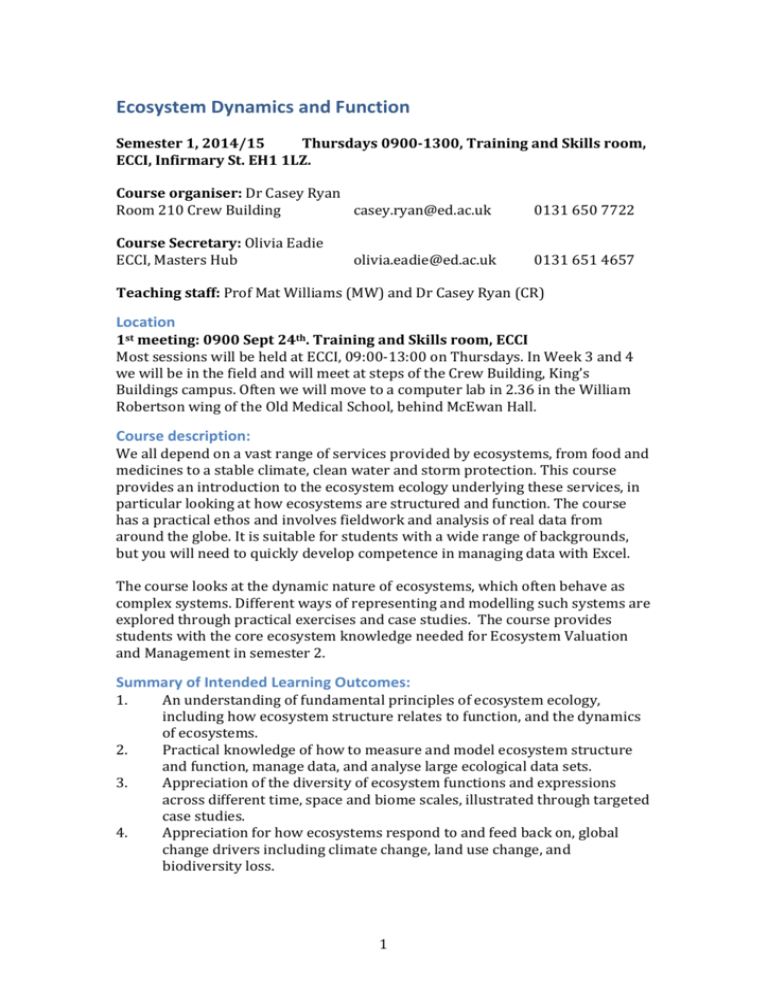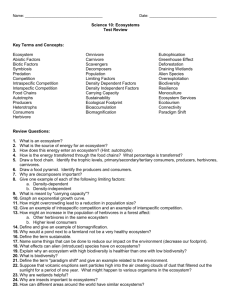doc
advertisement

Ecosystem Dynamics and Function Semester 1, 2014/15 Thursdays 0900-1300, Training and Skills room, ECCI, Infirmary St. EH1 1LZ. Course organiser: Dr Casey Ryan Room 210 Crew Building casey.ryan@ed.ac.uk 0131 650 7722 Course Secretary: Olivia Eadie ECCI, Masters Hub 0131 651 4657 olivia.eadie@ed.ac.uk Teaching staff: Prof Mat Williams (MW) and Dr Casey Ryan (CR) Location 1st meeting: 0900 Sept 24th. Training and Skills room, ECCI Most sessions will be held at ECCI, 09:00-13:00 on Thursdays. In Week 3 and 4 we will be in the field and will meet at steps of the Crew Building, King’s Buildings campus. Often we will move to a computer lab in 2.36 in the William Robertson wing of the Old Medical School, behind McEwan Hall. Course description: We all depend on a vast range of services provided by ecosystems, from food and medicines to a stable climate, clean water and storm protection. This course provides an introduction to the ecosystem ecology underlying these services, in particular looking at how ecosystems are structured and function. The course has a practical ethos and involves fieldwork and analysis of real data from around the globe. It is suitable for students with a wide range of backgrounds, but you will need to quickly develop competence in managing data with Excel. The course looks at the dynamic nature of ecosystems, which often behave as complex systems. Different ways of representing and modelling such systems are explored through practical exercises and case studies. The course provides students with the core ecosystem knowledge needed for Ecosystem Valuation and Management in semester 2. Summary of Intended Learning Outcomes: 1. 2. 3. 4. An understanding of fundamental principles of ecosystem ecology, including how ecosystem structure relates to function, and the dynamics of ecosystems. Practical knowledge of how to measure and model ecosystem structure and function, manage data, and analyse large ecological data sets. Appreciation of the diversity of ecosystem functions and expressions across different time, space and biome scales, illustrated through targeted case studies. Appreciation for how ecosystems respond to and feed back on, global change drivers including climate change, land use change, and biodiversity loss. 1 Course Outline W1 W2 W3 W4 W5 W6 W7 Sep18 Sep25 Oct02 Oct09 Oct16 Oct23 Oct30 W8 Nov -06 W9 Nov -13 W10 Nov -20 W11 Nov -27 Overview of the Ecosystem Concept and Global Change In week one we explore the concept of an ecosystem and the intellectual foundations of ecosystem science. Examples of the role that ecosystems play in the earth system and in supporting human wellbeing are examined. The role of ecosystems in global change and the idea of the Anthropocene is also presented. Ecosystems and the global carbon cycle The role of marine and terrestrial ecosystems in the global carbon cycle is analysed. In particular, we look at how the structure and function of ecosystems determines how much carbon is stored in different parts of the biosphere and how the fluxes between different components are being altered by global change drivers. Meet at Crew building, KB Fieldwork practical: the structure of forests We will visit the nearby Braidburn to conduct forest ecosystem measurements, including tree inventories and soil sampling. Students will collect a data set relating to forest structure and learn how to summarise the data in Excel. Meet at Crew building, KB Biogeochemical Fluxes Greenhouse gas emissions are changing the global climate. Efforts to mitigate and adapt to climate change require accurate measurements of gas emissions. This week we learn the methods for gas flux measurements, and collect and analyse data. Nutrient cycles Humans have caused unprecedented change to the nitrogen cycle, doubling the amount of available nitrogen on the planet. This has allowed us to feed a rapidly growing population, but has led to adverse effects on the environment and human health. Managing the nitrogen cycle is complex and we explore the issues from the perspectives of different groups. Biodiversity: what is it and how do we measure it? We look at how the diversity of life varies from the small-scale to the global (biogeography) and how this can be explained, measured and analysed. The concept of biodiversity is widely used and with many meanings and we will discuss ways of utilising the concept. • Lab practical: analysing diversity, including analysis of data from week 3. Biodiversity & ecosystem function Since 1992, researchers have developed increasingly sophisticated ways to understand how biodiversity is linked to the functioning of ecosystems. We look at the empirical data and the theory of how diversity affects ecosystem productivity and resilience, and how this affects ecosystem services. • Lab practical: predator-prey modelling exercise Student presentations on ecosystem structure Students will present their group work on the structure and diversity of forest ecosystems from around the globe (e.g. Brazil, Mozambique, Tanzania, USA, Canada and Scotland). This will be followed be a feedback session to allow you to identify your strengths and areas for improvement for assignment 2. Ecosystems as dynamic systems Here we look at ways of representing the complexity of ecosystems and approaches to understanding feedbacks, non-linearity and stable states. We analyse ecosystems stocks and flows by drawing Forrester diagrams Modelling global (eco)systems: an example of the global carbon cycle Putting together our knowledge of the carbon cycle and system modelling we explore the impacts of different climate mitigation techniques. CR Overview, feedback and exam preparation We will draw together the threads of the course and look at the challenges facing ecosystem science. Students can reflect on the course and provide feedback. CR 2 CR CR MW MW MW MW MW CR CR Assessment A1 30% A2 40% Exam 30% 3-page policy brief on a key issue of ecosystem functioning Ecosystem structure practical including a group presentation (with formative feedback) and individual report (40%) Examination Due Tuesday W7 – Oct 28th 12:00. Esubmission only. No hard copy. Presentations in week 8, individual write ups due W11 – Nov 25th 12:00 Esubmission only. Scheduled for the period 8th – 19th December 2014 Fieldwork For weeks 3 and 4 we will be outside whatever the weather. You will need to bring good shoes or walking boots, very warm clothes and a waterproof coat and trousers. If you don’t have waterproof gloves, bring a spare pair of normal gloves (or buy some washing up gloves). Every year a few people don’t bring enough clothes and get cold. The average weather for this time of year is between 2 and 10°C with a 30% chance of rain. You will also need to bring writing materials. Note that pencil is preferable, as it does not run in the rain. Full details of the fieldwork will be given in the week before each trip. Reading lists Reading lists will be provided for each week on Learn. The following texts are used throughout the course: 1. Chapin, Matson and Vitousek (2011) Principles of terrestrial ecosystem ecology. 2nd edition. Springer. This is available as an e-book from the library catalogue. There are also hard copies in the library. 2. Haefner, J. (2005). Modeling Biological Systems: Principles and Applications. 2nd edition. Springer. This is available as an e-book from the library catalogue. There are also hard copies in the library. The best prep you can do for this course is to read and work on the review questions in chapters 1, 2, 3, 14 and 15 of Chapin et al and chapters 1-3 of Haefner. You should also make sure you are comfortable plotting graphs in Excel, organizing data sets and writing equations. This includes filtering lists and using pivot tables. The University provides training and online support for Excel at: http://www.ed.ac.uk/schools-departments/information-services/help-consultancy/isskills/learning-resources/spreadsheets-data Also see: http://www.docs.is.ed.ac.uk/skills/documents/3606/3606.pdf If you are already comfortable with Excel, then I suggest that you learn how to use the free, open source data analysis and statistics package called ‘R’. The best way to do this is to get hold of: Gardener, M (2012). Statistics for Ecologists Using R and Excel. Pelagic Publishing Ltd. [e-book in library] Other literature which gives a flavour of the course content includes: 3. Steffen, W., J. Grinevald, P. Crutzen and J. McNeill (2011). "The Anthropocene: conceptual and historical perspectives." Philosophical Transactions of the Royal Society A. 369(1938): 842-867. 4. Curtis, A (2011). The Use and Abuse of Vegetational Concepts. Part 2 in the BBC TV documentary series All Watched Over By Machines Of Loving Grace. Available online. 5. Gruber N, Galloway JN (2008) An Earth-system perspective of the global nitrogen cycle. Nature 451: 293-296 6. Hooper, D.U. et. al. (2005) Effect of Biodiversity on Ecosystem Functioning: A Consensus of Current Knowledge. Ecological Monographs, 75 (1), 2005, pp 3 - 35. 7. Post, ERO et al (1999). Ecosystem consequences of wolf behavioural response to climate. Nature 401(6756): 905-907. 8. Biggs, R., Carpenter, S.R., Brock, W.A. (2009) Turning back from the brink: Detecting an impending regime shift in time to avert it. PNAS vol 106, no.3, 826-831. 3








